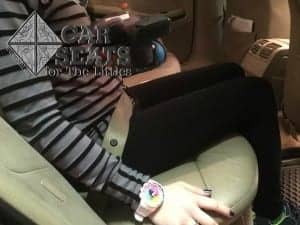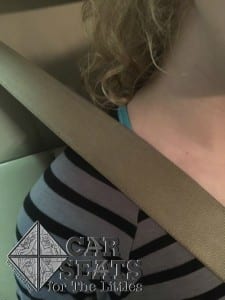Somehow that little mewling Little who arrived in your lives mere moments ago has grown and grown, and now you’re wondering if it’s time to do away with the booster seat altogether. But how do you know when it’s time? Parents might be tempted to go by local laws, some of which still state that a child as young as six can ride in the adult seat belt alone.
We know that age six, seven and usually eight is far too young to make this move. As long as a tween still fits in a booster seat– they’re under the height and weight limits for that booster seat, the vehicle seat belt is still on their collarbone, and they have support to the top of their ears from the car — there is no harm at all in leaving them in it.
Like every stage of car seats, rushing a child out of that stage is never the goal.
But how do you know when your tweenager can safely ride without a booster seat?
Here are the five steps we look at to see if an older child fits safely in the seat belt alone. A child must meet all five of these in order to fit safely in the seat belt.
1. Their knees bend comfortably at the edge, with their feet flat on the floor.
2. Their bum is all the way back in the seat.
3. The lap belt lies low on the hips, at the top of the thighs.
4. The shoulder belt crosses on the collarbone.
5. The tween/teen can stay seated like this for the entire ride. Even if they smirk.
Why are all five of these steps required? Let’s break them down.
If a child’s feet do not reach the floor and their knees don’t bend at the edge, they will slump forward.
It’s uncomfortable to have the edge of the vehicle seat in the back of your calves. If a passenger slumps during the ride, the vehicle seat belt will be on their soft abdomen, above their hip bones. In a crash, this positioning can result in seat belt syndrome, a serious injury to internal organs that occurs when the lap portion of the belt basically doesn’t stop until it hits the spine in the back. In addition, if our young passengers slump, the shoulder portion of the vehicle seat belt may not be in the correct position anymore either. If it’s too high it may be uncomfortable for the child and they will put it behind their back or under their arm, neither of which protects their upper body.
Most children need a booster seat well into their tween years, and some into their early teen years.
This comes as a surprise to most parents, who remember riding with nothing after they were six or seven, or maybe never sat in a seat at all. However, all health and safety organizations worldwide recommend that children use a booster seat of some sort until their bodies are basically adult sized — that’s usually right around 4 feet, 9 inches tall.
When a person is big enough, the vehicle seat belt does an excellent job of protecting them in a crash. When your tween is not yet big enough, the seat belt works against the child, causing injuries instead of preventing them.
When a tween does outgrow their booster and passes the five step test, they should still remain in the backseat until their 13th birthday. While this isn’t the law in all states, the CDC recommends waiting to move the child to the front seat and we do as well!
Keep in mind that vehicle back seats have very different shapes. Your tween may pass the five step test with ease in your car, but in another car with a very deep backseat they must continue to use a booster for another year or more.
Kids nowadays ride in some type of restraint for far longer than most parents might expect when they bring their newborns home. This is best practice and it’s helping more kids ride safely.
When in doubt, max it out. They aren’t little forever. There’s no rush to move them out of their car seat or booster seat.
The five step test is a guide for when kids can start riding without a booster; not when they must be out of one.





